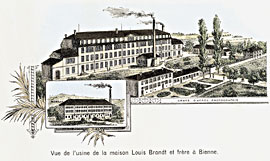

omega
Historique de la maison d'horlogerie Omega
NouveautEs par annEe
Voyage à travers le Temps / A Journey through Time

Entièrement consacré à l’évolution des créations d'Omega de la fin du XIXème siècle à aujourd’hui
1848: A La Chaux-de-Fonds, Louis Brandt fonde à 23 ans un "comptoir d'établissage".
1880: Un an après la mort de leur père, Louis-Paul et son frère César Brandt s'établissent à Bienne, où ils transforment leur entreprise en manufacture. Ils lancent leurs premiers calibres réalisés par procédés mécaniques, notamment sous marque Gurzelen, puis (1885) Labrador.
1889: Avec un effectif de 600 personnes et une production de 100'000 pièces par année, l'entreprise est déjà la plus grande de l'horlogerie suisse.
1903: Décès des frères Brandt. La succession est reprise par leurs quatre fils, dont le plus âgé, Paul-Emile Brandt, n'a même pas 24 ans. Celui-ci va exercer un règne quasiment sans partage durant un demi-siècle sur les destinées de la manufacture.
1930: La Grande Crise amène Omega à fusionner avec la manufacture locloise Tissot au sein de la SSIH - Société suisse pour l'industrie horlogère, qui absorbera Lémania, à la Vallée de Joux, en 1932. Les chronographes et compteurs de cette dernière complèteront utilement les montres de précision Omega et les articles "civils" (moyen de gamme) de Tissot.
1958: Président SSIH depuis 1955, Joseph Reiser prend la direction d'Omega. Après Marc Favre (1955), le groupe acquerra Rayville/Blancpain (1961), Lanco (1965) et Aetos (1969).
1970: Sous l'impulsion de Pierre Waltz, SSIH ne cesse de croître et de se multiplier, notamment en rachetant le roskopfier Economic Swiss Time Holding et l'américaine Hamilton en 1971 ou en créant de nombreuses filiales, comme SSIH Management Services (1971) et SSIH Equipment (1975).

Avec une cinquantaine de sociétés, une production de 13,5 millions de pièces, un chiffre d'affaires de plus de 700 millions de francs et un effectif de 7300 personnes, elle est au début des années septante le No 1 suisse et le No 3 mondial de la montre terminée.
1981: Touchée de plein fouet par la crise monétaire et la brutale récession des années 1975 à 1980, la SSIH doit être sauvée par les banques. Scénario identique, un an plus tard, pour l'autre géant de l'horlogerie suisse, l'ASUAG, fabricant d'ébauches No 1 et propriétaire, notamment, des marques Longines, Rado et (dès 1982) Swatch.
1983: Après assainissement financier et restructuration en profondeur, essentiellement par une concentration radicale de toutes leurs activités industrielles (recherche, développement et production) sous le seul et même toit de l'entreprise ETA à Granges, les deux groupes sont fusionnés pour donner naissance au holding ASUAG-SSIH.
1985: Celui-ci est repris par un groupe d'investisseurs privés placés sous la conduite du stratège inspiré de ces grandes manœuvres, Nicolas Hayek, qui en devient le grand patron. Rebaptisé la même année SMH -Société suisse de microélectronique et d'horlogerie, il va très rapidement renouer avec une croissance et une prospérité des plus vigoureuses pour se hisser au rang de première compagnie horlogère du monde! 1998: La SMH est rebaptisée The Swatch Group. 2003: Nick Hayek succède à son père à la direction opérationnelle du Swatch Goup.
1848: In La Chaux-de-Fonds, Louis Brandt establishes a "comptoir d'établissage" [assembly workshop] at the age of 23.
1880: One year after the death of their father, Louis-Paul and his brother César Brandt establish the company in Bienne, where they transform it into a manufacture. They launch their first mechanically-produced calibres, in particular under the Gurzelen, then (1885) Labrador trademarks.
1889: With a workforce of 600 people and a production of 100,000 units per year, the company is already Switzerland's biggest watchmaker.
1903: Death of the Brandt brothers. Their four sons take over, the eldest of whom, Paul-Emile Brandt, is not even 24. The company's fate lies firmly in his hands for the next half a century.

1930: The Depression leads Omega to merge with Tissot, a manufacture based in Le Locle, to form the SSIH – Société suisse pour l'industrie horlogère [Swiss watchmaking industry enterprise], which also takes over Lémania, based in the Vallée de Joux, in 1932. The latter's chronographs and stopwatches are the ideal complement to Omega's precision watches and the "civil" (mid-range) products of Tissot.
1958: Jo¬seph Rei¬ser, president of SSIH since 1955, takes over the management of Omega. The group acquires Marc Favre (1955), Rayville/Blancpain (1961), Lanco (1965) and Aetos (1969).
1970: Under the guidance of Pierre Waltz, SSIH contin-ues to grow, taking over the Roskopf watchmaker Economic Swiss Time Holding and the American Hamilton in 1971 and by creating numerous sub-sidiaries, such as SSIH Management Services (1971) and SSIH Equipment (1975). With some 50 individual companies, a production of 13.5 mil¬lion units, turnover in excess of 700 million Swiss francs and a workforce of 7300, in the early seventies the company is No. 1 in Switzerland and No. 3 in the world for finished watches.
1981: Gripped by the monetary crisis and the brutal recession from 1975 to 1980, the SSIH has to be rescued by the banks. The same thing happens a year later to the other Swiss watchmaking giant, ASUAG, No. 1 movement-blank manufacturer and owner in particular of the brands Lon¬¬gi¬nes, Ra¬do and (from 1982) Swatch.
1983: After a financial overhaul and far-reaching restruc-turing, essentially by radically concentrating all in-dustrial activities (research, development and pro-duc¬tion) under the same roof at ETA in Grenchen, the two groups merged to form the holding company ASUAG-SSIH.
1985: The latter is subsequently taken over by a group of private investors headed by the inspired strategist of such great moves, Nicolas Hayek, who becomes the Chief Executive Officer. Renamed SMH -Société suisse de microélectronique et d'horlogerie [Swiss microelectronics and watchmaking enter-prise], it grows rapidly and prospers, becoming the world's biggest watchmaking company!
1998: SMH becomes the Swatch Group. With Blancpain, Breguet and Swatch, Omega is today one of the most prestigious and dynamic members of the group.
2003: Nick Hayek succeeds his father as head of the group’s operational management.